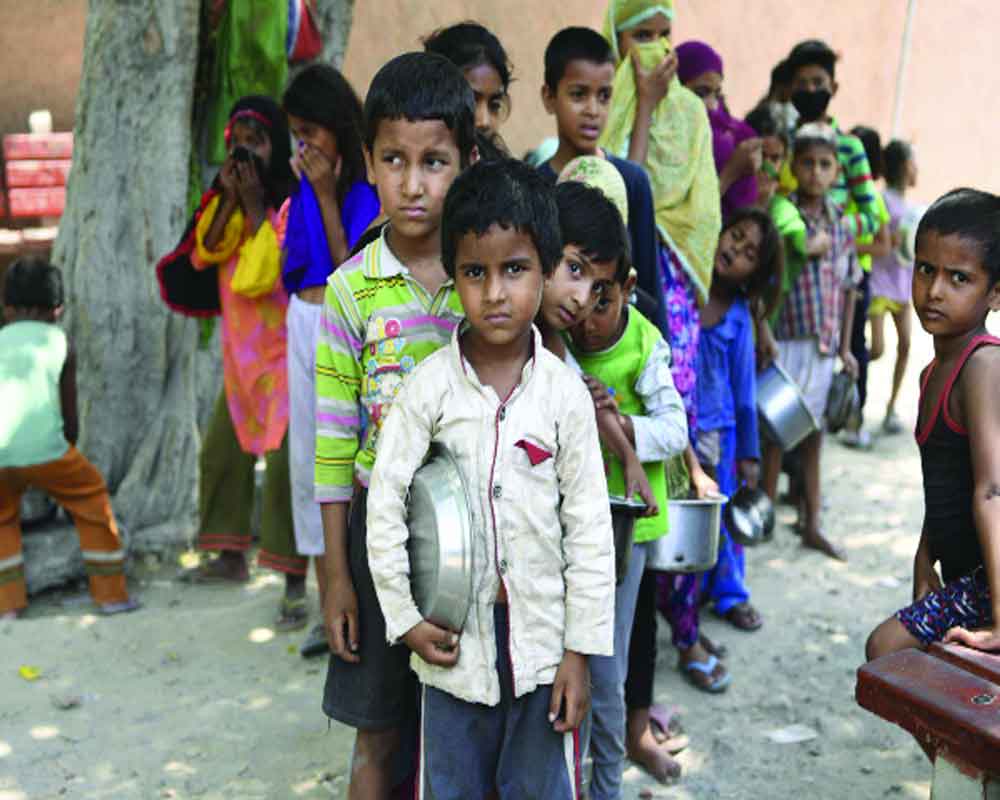Privation anywhere is a challenge to prosperity everywhere. As the worst form of deprivation human beings suffer from, it leads to untold miseries
Abraham Maslow’s theory of motivation propounds an undeniable truth and convinces conceivably about its universal application. Maslow considered physiological needs (hunger, thirst etc) and safety needs (security) as basic before the growth (esteem) and self-actualisation needs are satiated. This theory, if studied and deciphered in depth, would reveal the image of universality reflected by this theory. The message is loud and clear, and until the physiological and safety needs are satisfied, higher attainment like growth and self-actualisation is not possible. It enunciates that either at the motivation level or in growth prospective, if the basic requirements of people are not taken care of, the higher growth is not achievable in totality. This impresses upon one thing that priority number one of any Government is to go for eradication of poverty and amelioration of the predicaments of the impecunious so as to ensure inclusive growth with equitable distribution.
The World Bank defines poverty as deprivation of well-being, and it comprises many facets including low income and inability to acquire basic goods and services for survival with dignity. Confining poverty only to economic interpretation may be labelled as a one-dimensional concept. In a paradigm shift, Nobel laureate Amartya Sen recognised the aspects of multidimensional overtones/connotation of the concept and stated that poverty actually means not having enough material possession or income for personal needs. Poverty includes social and economic elements as well. He classified poverty as absolute poverty, meaning complete lack of means necessary to meet basic personal needs and defined relative poverty as associated with relative deprivation.
Mahatma Gandhi once defined poverty as the worst form of violence. As a violence-hit society finds itself immobile and paralytic, poverty and related predicaments hit life, health, future and surroundings in the severest possible way. It is further said that poverty anywhere is a challenge to prosperity everywhere. Poverty is a Herculean challenge to prosperity and renders development aspirations as a Utopia or chimera. Poverty, an anathema, has posed to be a conundrum as to how to eradicate it. About one-third of India’s population lives below the poverty line; the first obvious priority for any Government is to ameliorate the condition of the impecunious. But do we need a paradigm shift in planning and related implementation to achieve it?
Poverty eradication needs sincere efforts at all levels keeping the percolation concept in mind. The Indian Government has taken up several schemes like MGNREGA, SGSY, NRLM, IRDP, JNNURM and IAY as tools for a frontal attack on poverty through generation of work (mandays) for the poor while simultaneously making provisions for shelter, health care, nutrition and sanitation for this target group. But despite overall rapid growth and development, sizeable populations languish under severe and multi-faceted deprivation. The reasons can be social, political or bureaucratic; these are also the main factors for deterioration in the living standards. Other factors like rapid growth of population, lack of education and unemployment have affected the impecunious sections severely.
The different causes of poverty can be delineated broadly as illiteracy, low rate of economic development, low productivity in agriculture, unemployment, social factors and exclusion; hence for a holistic and inclusive growth all these factors must be considered. The vicious circle which entails poverty is that poverty leads to overpopulation, exacerbating the condition. The population rise being influenced by population dynamics, including population growth, leads to poverty. The poor go for more children for adding to their family workforce. This is also the reason why poor people don’t send their children to schools — a cause of illiteracy.
Factors like rapid population growth, early marriage of girls, illiteracy, poor health conditions, lack of access to financial resources and small land holdings become a burden on the nation’s income and growth, thereby adversely affecting the per capita income. Lack of entitlement, exclusion and deprivation, both relative and absolute, affecting people’s capability, are the reasons for poverty. Some experts feel that poverty is a reflection of the economic state of living where poor people experience scarcity of certain amenities essential to live like humans. Therefore, before targeting its complete eradication, poverty should be understood as a multifaceted concept, inclusive of socio-economic and political factors.
Martin Luther king, Jr, had stated that the curse of poverty has no justification in our age. Poverty is the worst form of deprivation human beings suffer, and it leads to human misery and sufferings. A few insalubrious aspects of poverty and its detrimental aspects for humans include deprivation from assimilation in social processes and economic activities; driving people to crime; creating circumstances exacerbating absolute and relative poverty; negatively affecting a nation’s socioeconomic, cultural and political environment; robbing the nation of its growth and prosperity; affecting the indicators of development in sectors like technology, production and improvement of socioeconomic welfare. In short, the consequences of poverty can be enlisted as low per capita income and low economic growth, interstate disparity, under-utilisation of skills/resources, violation of rights and a high crime rate.
(This article is the first part of a series.)
(The author is a superannuated senior IAS officer. The views expressed are personal.)


























